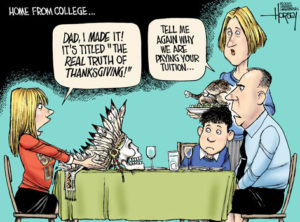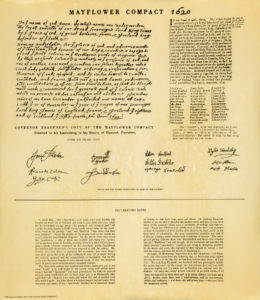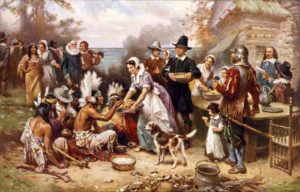Nov
24
Were the Pilgrims Really Intent upon Racial Genocide?
“The Thanksgiving story is an absolution of the Pilgrims, whose brutal quest for absolute power in the New World is made to seem both religiously motivated and eminently human…. It is unalloyed racist propaganda, a tale that endures because it served the purposes of a succession of the Pilgrims’ political heirs, in much the same way that Nazi-enhanced mythology of a glorious Aryan/German past advanced another murderous, expansionist mission.” — Glen Ford (2003, when Ford was co-publisher of The Black Commentator)
This year’s Thanksgiving post isn’t about the event so much as the reputation and legacy of the Pilgrims themselves. Let’s get right to it, shall we?
To cite The Daily Signal‘s Jarrett Stepman,
“The [subset of Puritans known as the] Pilgrims came to America as part of a quest to be distinct. They set out to the New World to establish a new religious, social, and political order — to be free from the constraints of the Church of England, and free from what they saw as the corrupting influences of Holland, where they were staying temporarily.
It wasn’t necessarily religious liberty or pluralism that the Pilgrims sought, but space to create a society based on strict Protestant Christian teachings. As Massachusetts Bay leader John Winthrop once exclaimed in a sermon, the new colonies would be as a ‘city upon a hill.’
The Puritans wanted to be a beacon of light in a fallen world. ‘The eyes of all people are upon us,’ Winthrop said.”
Indeed, they were and they are. Unfortunately, these days it is more popular in certain circles to not only undermine the traditional Thanksgiving story but to accuse the Pilgrims of horrific race-based crimes against Native Americans. They use modern-sounding terms like “the supremely white American holiday” and “[the goal of] unchallengeable white supremacy”. (Critical Race Theory, anyone?) They even accuse the Pilgrims of being ungrateful, belligerent drunks (among other things) at that first, unofficial Thanksgiving feast in the Fall of 1621.
You might think it was just Native American activists who have a beef. But, this type of rhetoric and accusations are made by Black commentators (see quote at top), Marxist publications (e.g., Revolutionary Worker), and self-described anarchist / (maybe) democratic socialists (e.g., Howard Zinn).
 However, careful readings of their claims (along with other sources) reveal habits like very selective uses of quotes, only relating part of the story (e.g., the events that preceded and help explain a particular attack), assumption of the “noble savage” theory, and the use of questionable & biased sources (which is what they say about “Eurocentric” accounts, of course). It is rife with conspiratorial speculation and the present-day, white-racism-is-everywhere mindset.
However, careful readings of their claims (along with other sources) reveal habits like very selective uses of quotes, only relating part of the story (e.g., the events that preceded and help explain a particular attack), assumption of the “noble savage” theory, and the use of questionable & biased sources (which is what they say about “Eurocentric” accounts, of course). It is rife with conspiratorial speculation and the present-day, white-racism-is-everywhere mindset.
One old stand-by is the claim that white Europeans, intent upon exterminating indigenous peoples, would offer (as gifts or for trade/sale) blankets to the natives that the two-faced white man knew were infected with smallpox or some other Eurasian disease. The unsuspecting recipients would take the blankets back to their people, and the disease would spread, sometimes wiping out whole villages at a time. The Native Americans were vulnerable because their immune systems had never encountered the virus before.
As I have discussed elsewhere,
“The term often used is “genocide”, which implies that the Europeans not only knew exactly what they carried but that they purposely infected the indios precisely in order to wipe them out, greatly reducing any opposition to European colonization and exploitation of the land. I haven’t figured out how the European colonizers could plan this and stay healthy themselves, especially with their extremely limited medical knowledge. (Details, details.) Of course, those that survived the new diseases were supposed to have been savagely massacred in war with the white man.”
This claim overlooks (or ignores) things like past estimates of indigenous populations now known to be inflated, natural occurrences of some of the diseases in question (or similar ones), inter-tribal wars, and, of course, there were likely some (many?) Native Americans who did get sick from unintentional transmission by well-meaning Europeans. Even if a few bad actors did figure out how to do this to their benefit, there is no proof that the Pilgrims/Puritans as a group had any such nefarious intent. Furthermore, conflicts and wars did arise in later years between some natives and some settlers, sometimes the result of one side or the other being manipulated by a third-party (e.g., an unscrupulous trapper). But, the anti-America/anti-White commentators always make the latter to be the bad guys while ignoring the atrocities of the former. In short, unfortunately, there were massacres and other nastiness perpetrated by both sides.
 But, all of that had yet to happen when the Pilgrims arrived off the coast of Massachusetts in November 1620. We may not know all the details about the first, unofficial Thanksgiving there in Plymouth, but there is no reason to think that the Pilgrims had anything but the above-mentioned goals in mind. They would have been appalled by any thoughts of genocide. (For an interesting historical study on the “smallpox in the blankets” narrative, likely inspired by the terrible epidemic of 1837–38, check out this article.)
But, all of that had yet to happen when the Pilgrims arrived off the coast of Massachusetts in November 1620. We may not know all the details about the first, unofficial Thanksgiving there in Plymouth, but there is no reason to think that the Pilgrims had anything but the above-mentioned goals in mind. They would have been appalled by any thoughts of genocide. (For an interesting historical study on the “smallpox in the blankets” narrative, likely inspired by the terrible epidemic of 1837–38, check out this article.)
Speaking of those goals for a “new religious, social, and political order”…
Grounded in a strong belief in covenants — both between God and man and between man and man — and influenced by the idea of the “social contract”, the Pilgrims created The Mayflower Compact. This “first constitution” was not so much a framework of government, but it is historically important as it recognized that the only legitimate government is one originating with the consent of the (soon to be) governed. That is, a covenant between men. With this in mind and God as their Witness, the signers pledged that they and their descendants would submit themselves to that established authority.
“The Mayflower Compact, a relatively simple document, established a kind of covenant between the citizens of the new colony. It was the first such document in the New World creating a “civic body politic” through clear, written guidelines. It was an indirect antecedent to the Constitution of the United States and our tradition of placing laws above men.” — Jarrett Stepman
That’s a pretty good legacy, and certainly something to be thankful for!
Happy Thanksgiving, everyone!
P.S. Here’s a great little video narrated by Michael Medved:
















